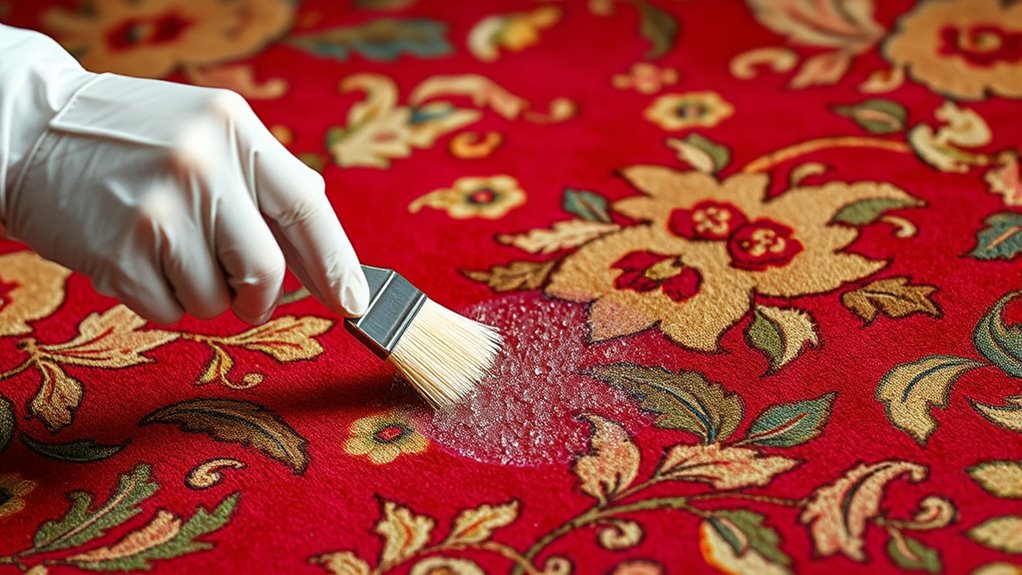When your pet soils a silk carpet, act fast to minimize damage. Gently blot the spill with a clean cloth to remove excess moisture, avoiding rubbing. Use a mild, pH-neutral solution like diluted silk or baby shampoo, applying it carefully to the affected area. Rinse with lukewarm water, then gently blot dry and allow it to air out completely. Proper techniques help preserve silk fibers; keep going to learn expert tips for best results.
Key Takeaways
- Act quickly to assess damage, remove excess moisture, and prevent stain setting on silk carpets.
- Use gentle blotting with mild, pH-neutral solutions specific for silk; avoid harsh chemicals.
- Rinse with lukewarm water and thoroughly blot to eliminate residual stain and odor.
- Employ natural remedies like vinegar and baking soda, testing on small areas first to prevent discoloration.
- Seek professional cleaning if stains persist, spread, or cause odor and damage to maintain silk integrity.
Assessing the Damage and Immediate Response
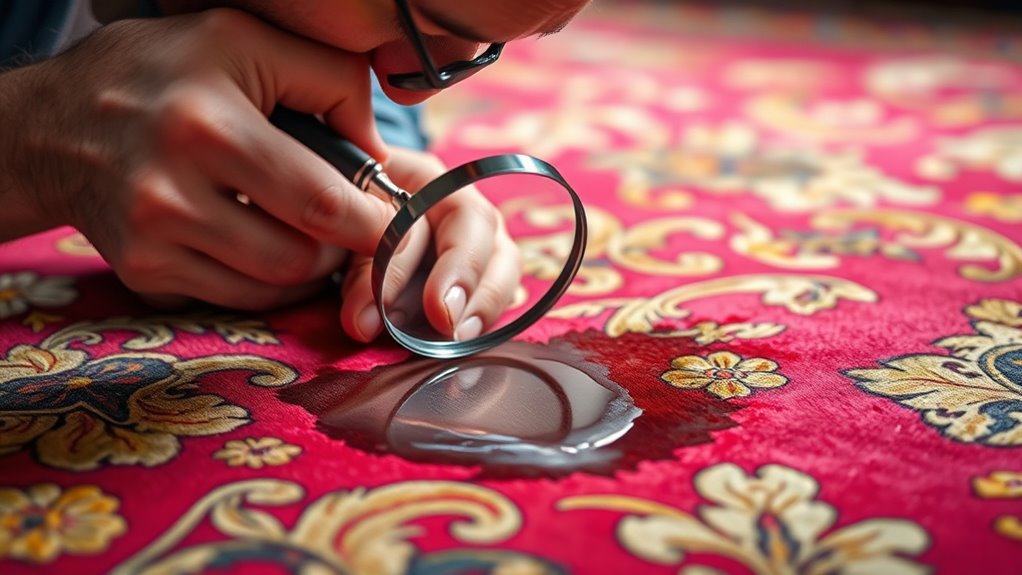
When your pet has an accident on a silk carpet, the first step is to quickly assess the extent of the damage. Check how much of the carpet is affected and whether the spill involves urine, vomit, or other substances. Ensuring pet safety is vital, so avoid rushing to clean without evaluating the situation first. Accident prevention begins with understanding your pet’s habits and maintaining a clean, safe environment. If the spill is fresh, act fast to limit absorption and prevent staining. Keep pets away from the area to avoid further damage or stress. Remaining calm helps you respond effectively. Recognizing early signs of damage allows you to take appropriate action promptly, minimizing long-term harm to your valuable silk carpet. Additionally, understanding the role of contrast ratio in projectors can help you better evaluate visual clarity in your home cinema setup. Being aware of AI in Education innovations can also inspire new ways to approach learning about carpet care and maintenance at home.
Blotting the Spill to Remove Excess Moisture
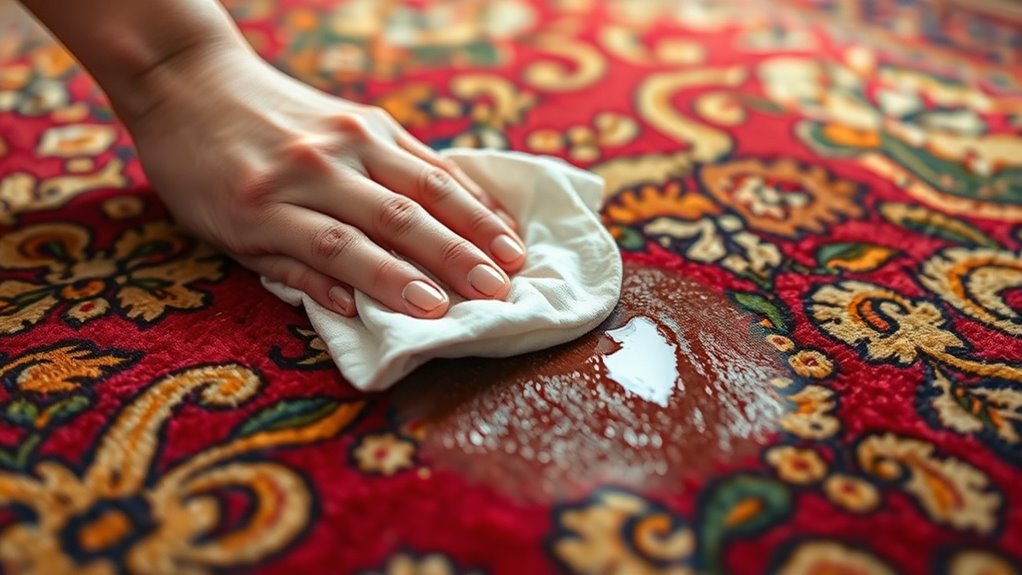
After evaluating the damage, the next step is to remove as much moisture as possible to prevent further staining or damage. Gently blot the spill with a clean, white cloth or paper towels, pressing softly without rubbing. This helps with pet stain removal by lifting the excess liquid without spreading it or pushing it deeper into the silk fibers. Be careful not to oversaturate the carpet, as too much moisture can lead to silk stain prevention issues later. Blot from the outside of the spill inward to contain the stain and avoid spreading. Consistently switch to dry sections of the cloth to maximize moisture absorption. This careful blotting process is essential to preserve your silk carpet’s integrity and minimize damage caused by pet accidents. Additionally, utilizing on-device AI capabilities can help identify the type of stain and recommend tailored cleaning methods, including proper drying techniques to ensure complete moisture removal without compromising the silk’s delicate fibers. Incorporating air purification during and after cleaning can also aid in removing residual allergens and dust that might settle after a spill. Proper ventilation and environmental control can significantly enhance the overall cleaning and drying process.
Preparing a Gentle Cleaning Solution for Silk

To prepare a gentle cleaning solution for your silk carpet, start by choosing mild detergents that won’t damage the delicate fibers. Use lukewarm water to prevent shrinking or discoloration, and steer clear of harsh chemicals that can cause irreversible harm. This careful approach helps guarantee your carpet stays clean and preserved. Incorporating exfoliation can also enhance the removal of surface dirt without harming the silk fibers. Additionally, selecting cleaning techniques that align with the authentic materials used in farmhouse bedrooms can help maintain their rustic charm and integrity. Understanding the 16PF personality traits of individuals involved in caring for your home can also improve communication and ensure proper maintenance practices. Being mindful of furniture placement can further prevent accidental damage during cleaning. Using a vacuum with gentle suction, such as those designed for luxury vinyl plank floors, can help protect the silk while effectively removing debris.
Choose Mild Detergents
Choosing the right detergent is essential for safely cleaning silk carpets. Using harsh chemicals can cause dye bleeding, ruining delicate fibers. To prevent this, opt for mild, pH-neutral detergents specifically designed for silk. These gentle cleaners reduce pet anxiety during cleanup and minimize damage to the fabric. Here’s a quick guide:
| Detergent Type | Suitable for | Key Benefit |
|---|---|---|
| Mild Silk Cleaner | Silk carpets | Prevents dye bleeding |
| Baby Shampoo | Delicate fibers | Gentle and safe |
| Special Silk Detergent | Pet stains | Reduces pet anxiety |
Always test a small area first. This ensures your silk remains vibrant and safe from damage.
Use Lukewarm Water
Using lukewarm water is essential for preparing a gentle cleaning solution for silk carpets. Silk fiber properties make it sensitive to temperature changes; hot water can weaken or damage the delicate fibers, while cold water may not effectively loosen stains. Lukewarm water helps facilitate safe and effective cleaning by promoting gentle chemical reactions in silk without causing harm. When you use water that’s too hot or cold, unwanted chemical reactions could occur, leading to color fading or fiber deterioration. By sticking to lukewarm water, you ensure that the silk remains intact and the cleaning process is mild yet effective. This careful temperature control respects the unique properties of silk, helping you clean pet accidents while preserving your carpet’s beauty. Additionally, understanding the field recording techniques can help you assess the environment and choose the best approach for delicate cleaning scenarios. Moreover, being aware of AI safety measures can guide you in selecting the safest cleaning methods for sensitive materials. Maintaining proper air quality during the cleaning process can also prevent the buildup of dust and other pollutants that might affect both the silk and indoor environment. Proper temperature management is crucial to prevent accidental damage during cleaning. Furthermore, using proper cleaning tools can enhance the effectiveness and safety of your cleaning routine.
Avoid Harsh Chemicals
Since harsh chemicals can damage delicate silk fibers, it’s important to opt for gentle cleaning solutions. Harsh chemicals can cause chemical damage, weakening the fabric and fading its natural luster. Instead, choose mild, silk-safe cleaners like diluted dish soap or specialized silk detergents. Avoid bleach, ammonia, or strong solvents, as they can irreparably harm your carpet. Always test your cleaning solution on a small, hidden area first to ensure it doesn’t cause discoloration. Using gentle solutions helps preserve the silk’s softness and integrity while effectively removing pet stains and odors. Additionally, understanding best laundry detergents can help you select the most suitable cleaning agents for silk. Remember, the goal is to clean thoroughly without risking chemical damage that could compromise the carpet’s beauty and longevity. Stick to mild, silk-friendly products for the best results.
Carefully Applying the Cleaning Solution
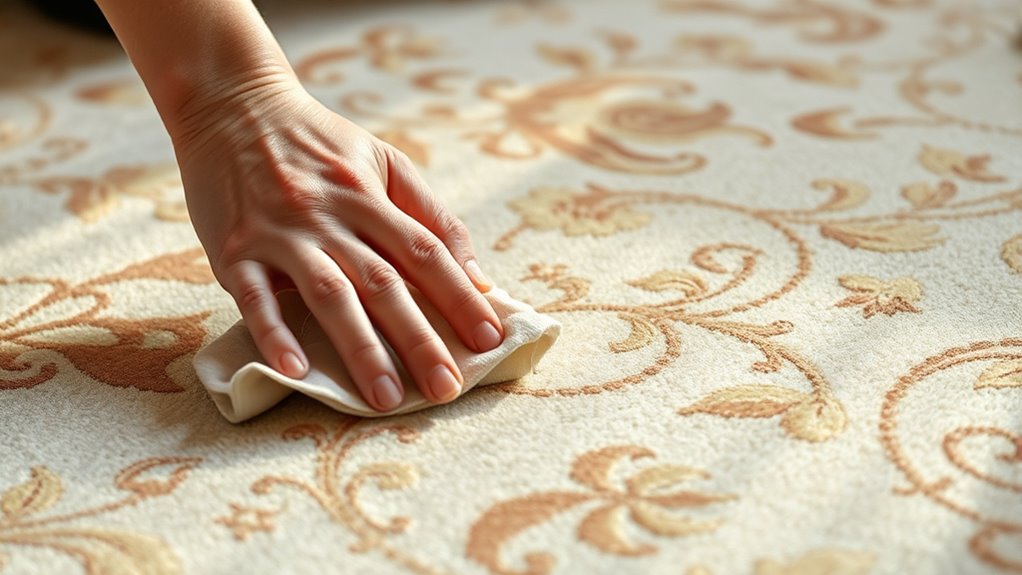
To avoid damaging your delicate silk carpet, you must apply the cleaning solution carefully and precisely. Use a soft cloth or sponge and dab gently, avoiding excessive saturation that could affect color fastness. Always test a small, hidden area first to ensure pet safety and prevent discoloration. Focus on the affected spot, not the entire carpet, to prevent unnecessary exposure. Keep the solution away from edges to maintain the carpet’s integrity.
| Step | Action | Tip |
|---|---|---|
| 1 | Apply small amount of solution | Use minimal liquid for control |
| 2 | Dab, don’t rub | Prevent fiber damage |
| 3 | Check for color change | Ensure color fastness remains |
Rinsing the Area Thoroughly and Gently
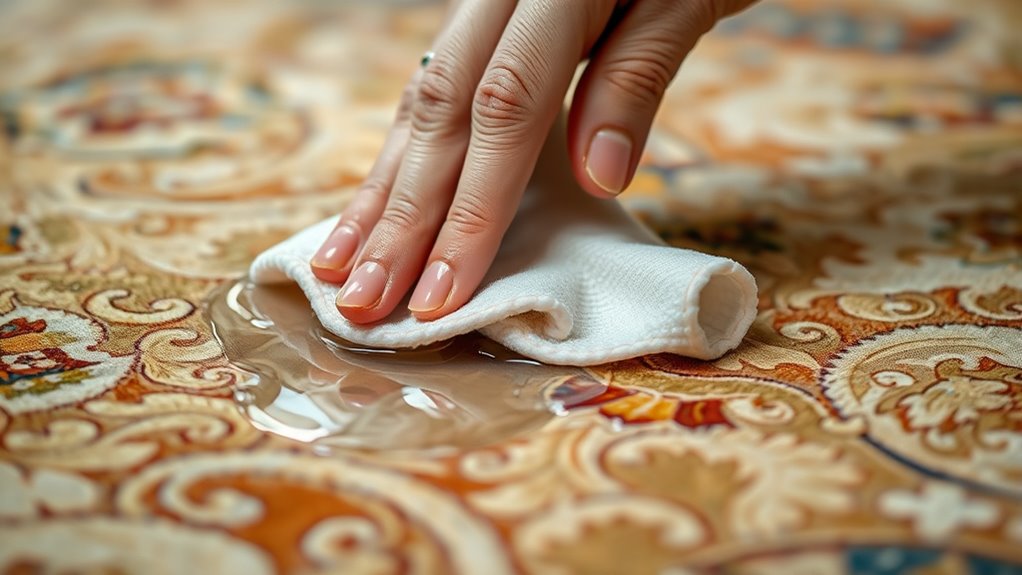
To rinse the area, use cold water to prevent damage to the silk fibers. Gently blot the spot with a clean cloth, avoiding any rubbing that could spread the stain or harm the fabric. This careful approach helps guarantee your carpet stays clean without causing additional harm.
Use Cold Water
When dealing with pet accidents on silk carpets, using cold water is essential for effective cleaning. It helps dilute the stain and prevents it from setting further. Gently rinse the affected area, making sure you don’t oversaturate the silk. This step is vital for pet stain removal and follows silk cleaning tips that protect delicate fibers.
To deepen your cleaning, consider these tips:
- Use a clean, soft cloth soaked in cold water to gently blot the spot.
- Avoid hot water, which can cause the stain to set.
- Rinse thoroughly to remove any residual pet urine or mess, making certain no stain or odor remains.
Following these steps ensures proper pet stain removal while preserving your silk carpet’s integrity.
Blot, Don’t Rub
After rinsing the affected area with cold water, it’s important to handle the spot gently. When performing pet stain removal on silk carpets, avoid rubbing the stain, as this can push the mess deeper into the fibers and cause damage. Instead, use a clean cloth or paper towel to blot the area softly, absorbing as much moisture as possible. Blotting helps lift the stain without spreading it or harming the delicate silk fibers. Remember, gentle pressure is key. For silk cleaning tips, always work from the outside of the stain inward to prevent spreading. Patience is essential; rushing can make things worse. This careful blotting preserves your silk carpet’s integrity while effectively removing pet stains, ensuring your carpet stays beautiful and well-maintained.
Drying the Silk Carpet Properly
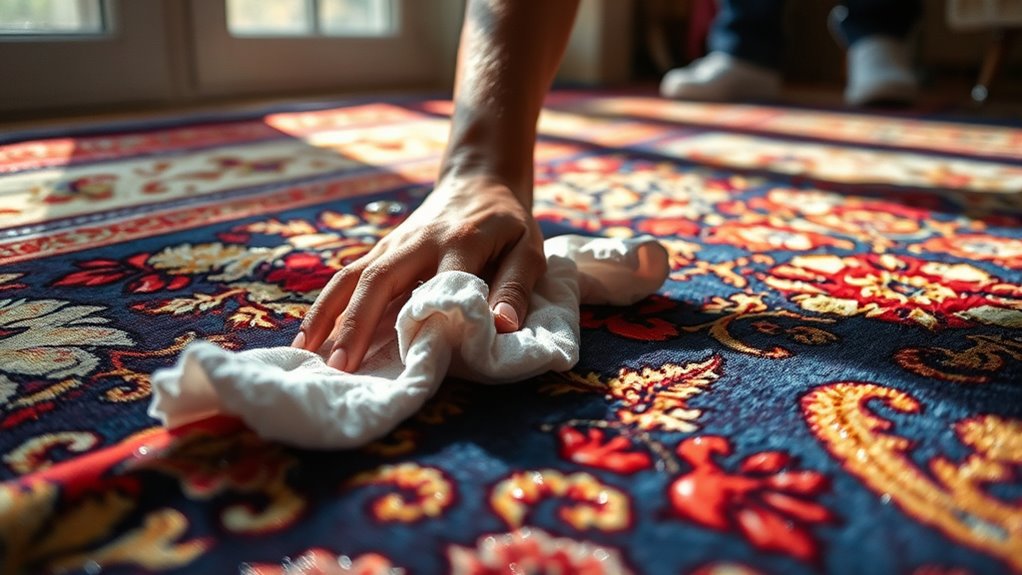
Properly drying a silk carpet after a pet accident is essential to prevent mold, mildew, and permanent damage. If you rush the drying process, you risk sun damage or trapping moisture, which worsens pet odor removal efforts. To guarantee thorough drying, follow these steps:
- Use fans or dehumidifiers to circulate air, speeding up moisture evaporation without exposing the carpet to direct sunlight.
- Avoid direct sun exposure, as prolonged sunlight can weaken silk fibers and cause fading.
- Blot excess moisture carefully, then let the carpet air dry in a well-ventilated area, ensuring all dampness is gone before restoring normal use. Proper drying preserves your silk carpet’s integrity and helps eliminate lingering pet odors effectively.
Using Natural Remedies for Persistent Stains
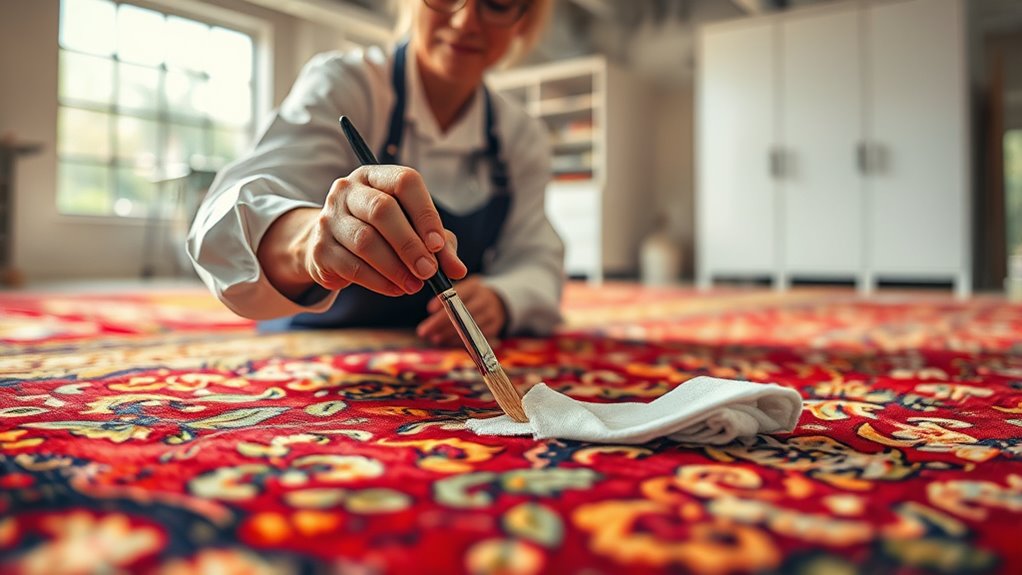
Natural remedies can be highly effective for tackling persistent pet stains on silk carpets, especially since harsh chemicals may damage delicate fibers. When dealing with stubborn stains, try using natural stain remedies like a mixture of white vinegar and water, which can lift stains without harming your silk. For pet odor removal, sprinkle baking soda over the affected area and let it sit for a few hours before vacuuming gently. You can also apply a paste of baking soda and water directly to the stain, then blot carefully with a soft cloth. These natural solutions not only help remove stains effectively but also neutralize odors, leaving your silk carpet fresh. Always test remedies on a small, hidden area first to guarantee they won’t cause discoloration.
Preventing Future Accidents and Maintaining Silk Care
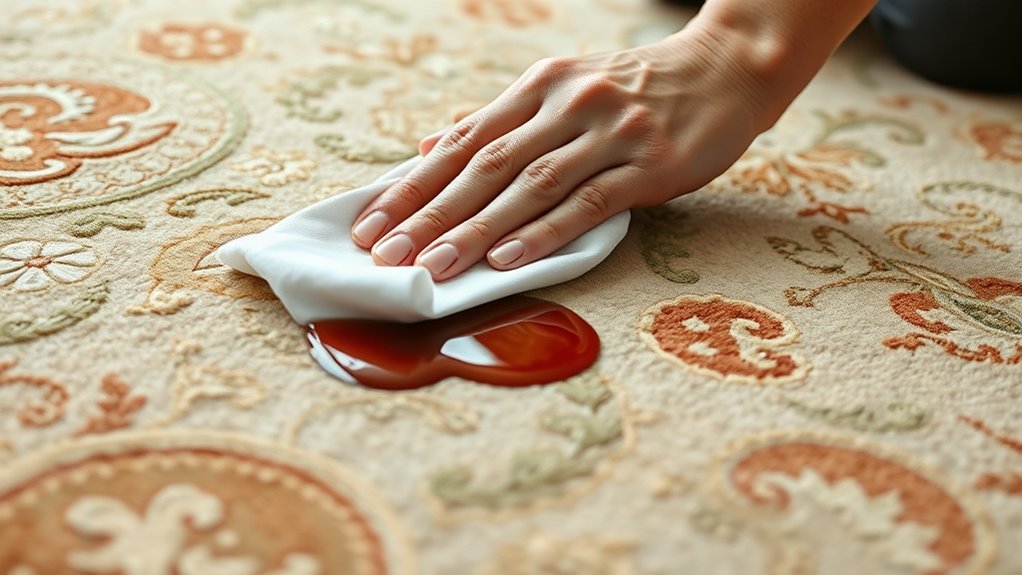
Preventing future accidents on silk carpets starts with proactive measures to keep your pets comfortable and your home clean. You can achieve this through effective pet training and pet proofing methods. First, establish a consistent schedule for bathroom breaks to reduce accidents. Second, use pet-proofing techniques such as barriers or deterrents to restrict access to silk carpets. Third, reinforce positive behavior with rewards when your pet uses designated areas. Regularly monitor your pet’s habits and address any issues early to prevent accidents from becoming frequent. By combining pet training with thoughtful pet proofing, you protect your silk carpets and ensure a cleaner, safer environment for everyone. These steps help maintain the beauty of your silk while fostering responsible pet behavior.
When to Seek Professional Restoration Services
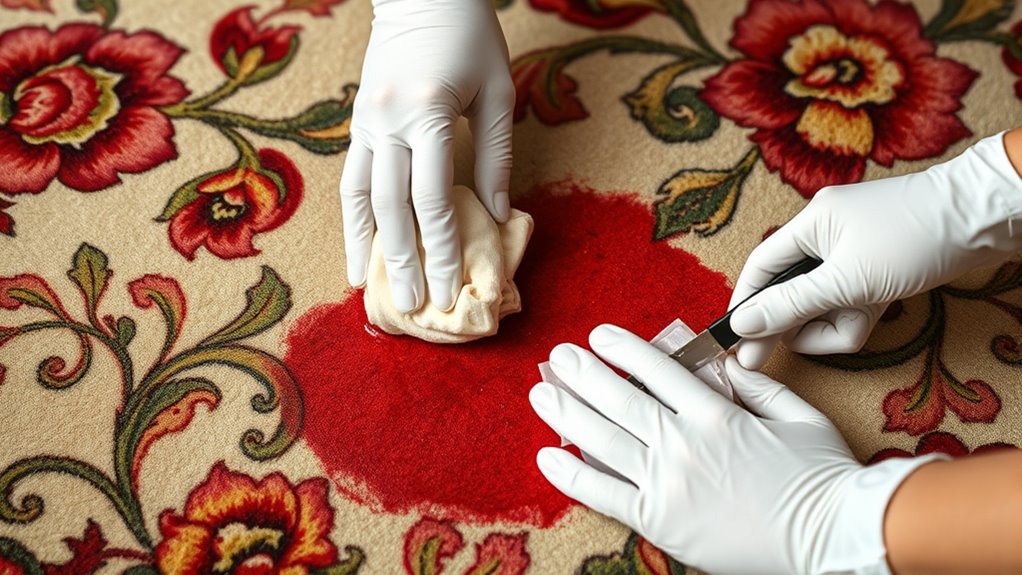
Knowing when to call in professional restoration services is essential to protect your silk carpet from long-term damage. If stains are stubborn or spreading despite your efforts, it’s time to seek expert help. Professional cleaning can effectively remove deep-set stains and odors, preventing deterioration. Consider professional stain removal if homemade solutions don’t work within 24 hours.
| Signs to Call Experts | What They Offer |
|---|---|
| Persistent stains | Deep cleaning and stain removal |
| Odor remaining | Odor neutralization |
| Discoloration | Gentle, specialized cleaning |
| Spreading damage | Damage assessment and repair |
| Uncertainty about severity | Expert advice and intervention |
Frequently Asked Questions
Can Pet Accidents Permanently Stain Silk Carpets?
Pet accidents can sometimes cause permanent stains on silk carpets if not addressed promptly. Proper pet stain removal is vital for silk carpet maintenance, as silk is delicate and prone to damage. You might not be able to completely remove all traces of the stain, especially if it soaks deep into the fibers. Act quickly, use gentle cleaning methods, and seek expert advice to prevent lasting damage and preserve your silk carpet’s beauty.
Are Commercial Stain Removers Safe for Silk?
Commercial stain removers aren’t always safe for silk, so you should check their chemical safety before use. Many contain harsh chemicals that can damage delicate fibers or cause discoloration. To prevent stains effectively, opt for gentle, silk-safe products or natural solutions. Always test a small, hidden area first, and act quickly to minimize damage. Proper stain prevention starts with understanding what’s safe for silk to keep your carpet looking beautiful.
How Often Should I Professionally Clean Silk Carpets After an Accident?
Imagine your silk carpet faces a pet accident; you wonder when to call a professional cleaner. Typically, after an incident, you should schedule a professional cleaning for routine maintenance within 24 to 48 hours. For ongoing pet issues, cleaning frequency might increase to every 6-12 months. Regular professional cleaning helps preserve silk’s delicate fibers, ensuring your carpet stays beautiful and odor-free, while preventing stains from setting in permanently.
What Are the Signs of Silk Fiber Damage From Pet Stains?
You’ll notice fiber deterioration when the silk fibers become frayed or feel brittle, indicating damage from pet stains. Color fading is another sign, where the vibrant hues of your carpet lose their luster, revealing dull or uneven patches. These issues happen because pet accidents can weaken the delicate silk fibers and cause dye loss. If you spot these signs, it’s essential to act quickly to minimize further damage and preserve your carpet’s beauty.
Is It Safe to Use Bleach or Harsh Chemicals on Silk Carpets?
You should avoid using bleach or harsh chemicals on silk carpets because of bleach caution and chemical risks. These substances can weaken the delicate fibers, cause discoloration, and damage the fabric permanently. Instead, opt for gentle, silk-safe cleaning solutions. Always test any cleaner on a small, hidden area first. Protect your silk carpet’s beauty and integrity by steering clear of strong chemicals that can cause irreversible harm.
Conclusion
By following these gentle steps, you’ll safeguard your silk carpet from pet mishaps and keep its beauty alive. Imagine your carpet as a delicate garden, each stain a fleeting shadow that can be brushed away with care. With patience and the right approach, you’ll restore its grace and ensure your home remains a haven of elegance, even amidst unexpected pet surprises. Remember, a little care goes a long way in preserving your silk’s timeless charm.
